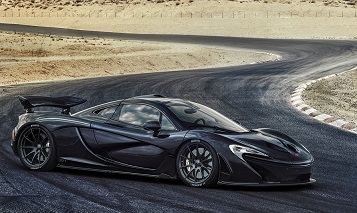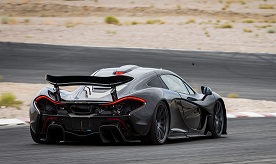The astonishing new McLaren P1™, which debuts in production form at the Geneva Motor Show, has a clear goal – to be the best driver’s car in the world on road and track. To achieve this objective, McLaren is using all of its 50 years of racing experience and success, especially in the fields of aerodynamics and lightweight carbon fibre technology.
has a clear goal – to be the best driver’s car in the world on road and track. To achieve this objective, McLaren is using all of its 50 years of racing experience and success, especially in the fields of aerodynamics and lightweight carbon fibre technology.
The result is a car that has an unprecedented amount of downforce for a road vehicle: similar levels to a GT3 racing car and yet with even greater ground effect. This downforce not only boosts cornering and braking performance. It also helps balance, stability and driveability at all speeds.
‘McLaren introduced the carbon fibre chassis to the world of Formula 1 in 1981 with the MP4/1, and we had the first carbon-bodied road car,’ says McLaren Automotive Executive Chairman Ron Dennis. ‘We have always been at the cutting edge of vehicle aerodynamics, and all of this experience has gone into the new McLaren P1™. Twenty years ago, with the McLaren F1, we raised the supercar performance bar. With the McLaren P1™, we have redefined it once more.’
The best driver’s car in the world must also have exceptional straight-line performance and instant throttle response. To deliver this, the McLaren P1™ uses an innovative IPAS petrol-electric powertrain comprising a substantially revised 3.8-litre twin-turbo V8 petrol engine, coupled to a single electric motor, collectively known as M838TQ. Combined power output is 916 PS (903 hp). As important as absolute power is the electric motor’s ability to provide instant torque, making the powertrain superbly responsive. It is also amazingly efficient. Carbon dioxide emissions are less than 200g/km, and it can cover more than 10 km in electric-only mode.
Top speed is electronically limited to 350 km/h (217 mph), with the 0-100 km/h standing start acceleration taking less than three seconds .The McLaren P1™ will power from rest to 200 km/h in less than seven seconds, and on to 300 km/h in less than 17 seconds – a full five seconds quicker than the McLaren F1.
‘We believe the McLaren P1™ is the most exciting, capable, technologically advanced and most dynamically accomplished supercar ever made,’ says McLaren P1™ programme director, Paul Mackenzie. ‘It may not be the fastest car in the world in absolute top speed, but that was never our goal. Rather, we believe it is the fastest ever production car on a racing circuit, a much more important technical statement, and far more relevant for on-road driving. It is a true test of a supercar’s all-round ability. Plus many owners will use the car on the circuit, at special track and test days.’
The astonishing technology developed for the McLaren P1™ includes active aerodynamics and adjustable suspension – both now banned in Formula 1, due to being seen to give a performance advantage. Airflow is optimized around the body through the use of an active wing and underbody devices. The adjustable rear wing can extend from the bodywork by 120mm on road, up to 300mm on the race track, maximizing the levels of downforce. The wing is directly inspired by Formula 1 design, with the intersection of the double element rear wing and design of the endplates being the same as that on the 2008 championship winning MP4-23.
In addition, the McLaren P1™ also features adjustable ride height as part of the new hydro-pneumatic suspension. The revolutionary RaceActive Chassis Control (RCC) can lower the car by 50mm in Race mode, to produce ground effect aerodynamics. It also features adaptive spring rates, roll control, pitch control and damping, all providing a huge range of adjustment, making the McLaren P1™ perfect for either road or track. In Race mode, the spring rates stiffen by 300 per cent, allowing the McLaren P1™ to corner at more than 2g.
Formula 1-inspired technology permeates the McLaren P1™. The revolutionary new carbon fibre MonoCage monocoque forms a complete structure incorporating the vehicle’s roof and its distinctive snorkel air intake – a styling feature inspired by the McLaren F1 road car.
McLaren is an acknowledged world leader in carbon technology. The material offers lightness, strength and rigidity – improving performance, safety, handling, agility, durability, efficiency and ride comfort. The body panels of the McLaren P1™ are also made from lightweight yet strong carbon composite, with their complex shapes tuned for optimal aerodynamics.
The McLaren P1™ was designed from the outset to prioritise aerodynamic performance – just like a Formula 1 car. As with a Formula 1 car, wind tunnel testing and CFD (computational fluid dynamics) aerodynamic modelling were used to optimise the aerodynamic flow, both to provide incredible levels of downforce and to cool the powertrain. The result is 600kg of downforce at well below maximum speed (257 km/h / 161 mph) in Race mode, which is considerably higher than most other high performance supercars, and more in line with the levels of downforce generated by a GT3 racing car. This downforce improves the car’s cornering ability, especially in high speed corners. Balance, agility and controllability are all outstanding.
Other areas of Formula 1 technology evident on the McLaren P1™ include the revolutionary layered carbon ceramic brakes, developed for the road by McLaren’s Formula 1 partners Akebono. The highly efficient IPAS (Instant Power Assist System) is a development of KERS (Kinetic Energy Recovery System) used on Formula 1 cars, while DRS (Drag Reduction System) is also used on the McLaren P1™, giving extra power and straight-line speed both at the touch of a button. Brake Steer – an outlawed Formula 1 technology – is also used on the McLaren P1™. It improves cornering behaviour and cornering speed.
‘The carryover Formula 1 technology on the McLaren P1™ is palpable,’ notes Dick Glover, Research Director. ‘From the aero work, to the carbon fibre MonoCage monocoque and body, to the active suspension [now banned in Formula 1] to the Brake Steer [now banned in Formula 1], to the turbocharging [which comes back into Formula 1 in 2014], to many other engine examples including the low crankshaft and dry sump lubrication.’
The IPAS petrol-electric powertrain also ties in with upcoming Formula 1 regulations. From next year (2014), Formula 1 cars will have hybrid power, including an electric mode for the pit lane.
The McLaren P1™ name is also inspired by Formula 1. P1 refers to ‘first place’ or ‘position one’ – particularly fitting as McLaren has 182 Grand Prix victories and 155 pole positions to-date, in its 47-year Formula 1 history. There is also heritage in that name: the McLaren F1 was initially known internally within McLaren as Project 1, or P1.
Despite the huge performance, the McLaren P1™ is also a refined and comfortable high-speed supercar. ‘It is designed to be driven to the racing circuit, with great levels of comfort and refinement,’ says McLaren P1™ programme director, Paul Mackenzie. ‘And then to be used on the racing circuit, where it will offer an experience matched only by purpose-built race cars.’
Adds Chief Design Engineer Dan Parry-Williams: ‘It’s fast on the racetrack but still fast, comfortable and refined on the road.
‘The brief was to make a refined, fuel efficient car that is faster than anything else on the racetrack but that is also as fast as anything you could use on the road while not compromising ride or comfort.’ The ownership experience with the McLaren P1™ will be as special as the car itself, Greg Levine, McLaren Automotive Sales and Marketing Director explains: “Owners will become part of the McLaren family, if they aren’t already. To maintain exclusivity, we have closely monitored demand, and announced a production number of just 375 units – a figure that will ensure the McLaren P1™ will remain a rarity and, if spotted on the road, an unforgettable sight.”












